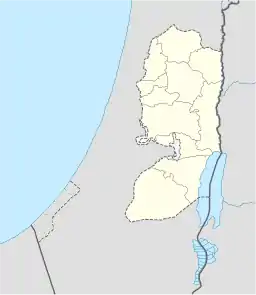Ancient underground quarry, Jordan Valley
An ancient underground quarry in the Jordan Valley was discovered in 2009 by University of Haifa archeologists.[3][4] The quarry is located about 3 miles (5 km) north of Jericho, West Bank.[3][4][5]
 Shown within the West Bank | |
| Location | near Jericho, West Bank |
|---|---|
| Region | Jordan Valley |
| Coordinates | 31.912444°N 35.462181°E |
| Type | quarry |
| Length | 100m[1] |
| Width | 40m[1] |
| Area | 0.4-hectare[1] |
| Height | 4m[1] |
| History | |
| Founded | 1st-century AD[2] |
| Periods | Roman and Byzantine[2] |
| Site notes | |
| Archaeologists | Adam Zertal |
| Management | Israel |
Description
The cave is located in the desert north of Jericho, 10 metres (40 ft) beneath the surface. It spans more than 1-acre (0.4-hectare) and its main hall is supported by 22 pillars.[1][3] Various symbols, including Byzantine crosses, a zodiac-like symbol and Roman numerals are engraved upon the pillars.[2][3] An etched Roman legion's pennant indicates that it was used by the Roman Army.[3] The cave was dug around 2,000 years ago and served as a large quarry during the Roman era. The chamber's run as a quarry likely lasted approximately 400 to 500 years.[4] It may subsequently have been used as a monastery and some believe it may have marked a biblical site which became sacred to ancient Christians.[1][3] Others, while admitting the possibility that the cave could have been associated with monastic activity, claimed that the etched crosses alone cannot confirm the existence of a church, since they may have been made by random pilgrims which was a common phenomenon at the time.[6]
Dr. Adam Zertal, who led the expedition, contends that the spot may mark the ancient site named Galgala. Referring to the Byzantine era Madaba map, he notes a site called Galgala is depicted next to an inscription that reads "Dodekaliton", which translates as "Twelve Stones". The place is marked at a distance from Jericho that matches the cave's distance from the city. The map shows a church next to Dodekaliton and today the remains of two ancient churches are located near the cave. Zertal suggests that the meaning of "Twelve Stones" relates to the biblical verses that describe the twelve stones that the Children of Israel placed in Gilgal and may be understood as a reference to the quarry that was dug in the place the Byzantines identified as Gilgal.[7]
References
- Ran Shapira. Discovery of giant underground quarry in Jordan Valley may rock archaeological thinking, Haaretz, (June 22, 2010).
- Underground Christian Cave From 1st Century A.D. Exposed Near Jericho, LIFE, (June 24, 2009).
- Lefkovits, Etgar (June 21, 2009). "Huge Roman-era cave found by Jericho". Jerusalem Post.
- Photos: "Glorious" Ancient Chamber Found in Israel (3), National Geographic (June 30, 2009).
- "2,000-year-old quarry found in West Bank with Christian symbols on walls". Reuters. Boston.com. June 22, 2009. Retrieved December 10, 2010.
- Photos: "Glorious" Ancient Chamber Found in Israel (4), National Geographic, (June 30, 2009).
- Cave Dating From The Year 1 A.D. Exposed In Jordan Valley, Science Daily, (July 7, 2009).
